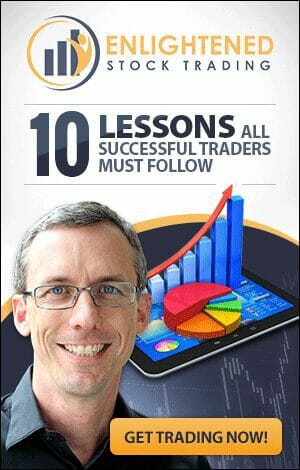Trend trading or trend following In stocks is a strategy that has been around for a very long time. This trading strategy has been studied Extensively in several of the major stock markets around the world, however. There has not been. A good study. Into the effectiveness of trend following. That covers a very broad range of stock markets globally. In this article I am going to share with you. The results of A trend trading system? Applied to a broad range of global stock markets.
What are the biggest challenges that traders face Is inconsistency of trading results. Inconsistency is often caused by insufficient diversification. Because. Each market may. Move. In strong trends for only some of the time. And. Trend traders in particular. Will spend a large proportion of their time in drawdown. If they are only trading one stock market. From the longside. Too many traders tend to be myopic in their focus and only trade one or two large international markets for example the US stock market. whenever I talk to traders about diversifying internationally the first market they usually go to in their mind is the US stock market the question is is this the best move to diversify your portfolio of trading systems?
In this article I present the backtests of a very simple trend trading system applied to a wide variety of markets. as you will see some of the results are very surprising some markets stand out as exceptional trading opportunities while others suffer from very inconsistent results overtime. What this demonstrates is that each market has its own unique character and while this one system cannot rationally be expected to perform exceptionally well in all markets around the world, this article provides an excellent starting point for further research to develop trend trading systems specific to each market. indeed this system is rudimentary in nature however the enlightened stock trading approach to trading system development requires that the system should have an edge in its rawest form before optimization filtering and fine tuning is undertaken. If this is not the case then chances are all of that work optimising fine tuning and filtering is purely resulting in curve fitting rather than improving of your raw edge.
So the purpose of this article is to demonstrate where broad based trend trading in stocks provides traders with a raw edge worth pursuing. Below you’ll see I’ve tested trend trading in the Australian market the US market the whole common market Shanghai the Philippines Malaysia Japan Taiwan London many European countries and others… The results could shock you.
My goal in this article is to make you think more deeply about your global diversification count system development efforts and hopefully show you that casting your net further afield into alternative markets is indeed an opportunity worth investigating.
Rules of the Trend Trading System
For the purpose of this research I have started with a very simple (but effective) trend trading system and applied this to each market. The rules of the stock trend trading system are:
BUY the next bar on open if:
- The stock’s closing price is equal to the 200 day highest close
- The stock’s closing price is above the 200 bar simple moving average
- The 20 day average turnover (Close * Volume) is greater than 1 million U.S. dollars or equivalent per day
SELL the next bar on open if:
- The stock touches a 25% trailing stop intraday
Position Sizing and Portfolio Management:
- Each trade is allocated 5% of equity
- Maximum of 20 simultaneous positions
- No leverage
Commission and Slippage Assumptions:
- Commissions have been included in the study and have been allocated at 0.5% per side
- Given the generous liquidity requirement used this Commission allowance should be more than sufficient to cover slippage and commissions in most markets
Clearly this is not the most sophisticated trading system in the world and in fact inside The Trader Success System, students get access to several high performing trend trading systems that dramatically outperform this simple system in backtesting.
Despite the simplicity of this system, in many markets it does outperform buy and hold, so this basic trend trading approach should serve as an adequate system to compare the “trendiness” of each market we’ve investigated.
Once a potentially profitable trend trading market is found using this very raw system a more refined and profitable approach can be developed rather quickly.
Backtesting the Portfolio
The data used for this backtest comes from Norgate for US, TSX and ASX and includes delisted stocks. For other markets the data was sourced from Metastock.
Trend Trading Performance Statistics
We will evaluate the performance using the following performance metrics:
- Compound Annual Return
- Risk Adjusted Return
- Maximum Historical Drawdown
- CAR/MDD
- Average Profit Per Trade
- Percent Winners
We will also use the shape of the equity curve (plotted on a logarithmic scale) to evaluate how ‘tradeable’ the market is with a trend trading system. Finally we will look at the underwater equity chart to evaluate the drawdown profile.
Stock Markets We Backtested
The stock markets that we have backtested and included in this study include:
- USA
- NYSE
- Nasdaq
- AMEX
- Delisted
- Toronto Stock Exchange (TSX)
- Australian Stock Exchange (ASX)
- Hong Kong Stock Exchange (HKSE)
- Shanghai Stock Exchange
- Philippines Stock Exchange
- Malaysia Stock Market (Bursa Malaysia)
- Tokyo Stock Exchange
- Singapore Stock Exchange
- Bovespa (Brazil Stock Market)
- Xetra
- OMX Exchange (Nordic and Baltic)
- Tel Aviv (Isreal)
- Mexican Stock Exchange
US Stock Market Trend Trading Performance
The US stock market trend trading performance was extremely underwhelming. While this broad based trend trading strategy did work well in the US Stock Market up until the Global Financial Crisis in 2007, since then results have been extremely volatile and the drawdown of the strategy has increased.
It certainly appears as though trend trading does have an edge in the US Stock Market, however when applied to the whole market this edge is weak and seems to be decaying over time. In the next section we will look at the different US exchanges separately to understand whether the same findings apply at an exchange level for the NYSE, Nasdaq and AMEX exchanges.
Backtest Statistics – US Stock Market Trend Trading
- Annual Return 8%
- Risk Adjusted Return 8%
- system % drawdown -59%
- CAR/MaxDD 0.14
- Average Profit/Loss 5%
- Percent Winners 37%
- Average Win / Average Loss 2.42
Backtest Equity Curve for US Stock Market Trend Trading System (Log Scale):

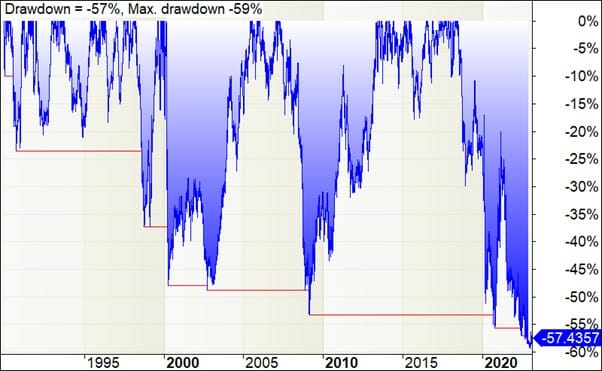
NYSE Trend Trading Performance
The New York Stock Exchange trend trading performance was quite a bit better than the whole US market combined. The compound annual return was 10% and the drawdown was 42% compared to 8% and 59% respectively for the whole market. This implies that within the US Stock Market the different exchanges certainly have quite different performance / behavioural characteristics.
Based on the performance statistics and the equity curve below it certainly seems as though a viable trend trading system could be developed for the New York Stock Exchange.
Backtest Performance Statistics for NYSE Stock Market Trend Trading System:
- Annual Return % 10%
- Risk Adjusted Return % 10%
- system % drawdown -42%
- CAR/MaxDD 0.24
- Profit/Loss 16%
- Winners 43%
- Average Win / Average Loss 3.52
Note that these backtest results are only on currently listed NYSE stocks because the delisted stock history provided by Norgate does not specify which exchange they were listed on prior to delisting. Performance metrics are still useable because despite some survivorship bias in the results, you will see in the delisted stocks section of this analysis that the trend trading performance for stocks that have now been delisted was actually stronger than for currently listed stocks.
Backtest Equity Curve for NYSE Stock Market Trend Trading System (Log Scale):
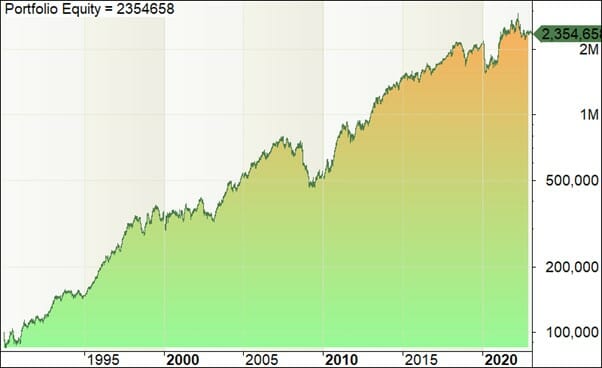
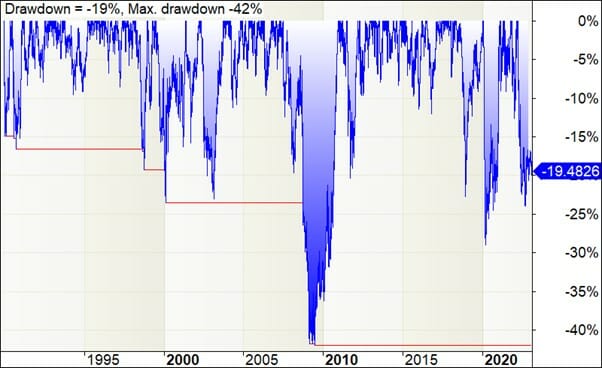
Nasdaq Trend Trading Performance
The trend trading strategy applied to the Nasdaq stock exchange performed extremely strongly up until 2000 during the dot com bubble, however since that time the performance has tapered off substantially. While still profitable the simple trend trading system applied to the Nasdaq since 2000 was underwhelming.
A viable trend trading system could still potentially be developed for the Nasdaq stock exchange, however the decay since 2000 indicates to me that the NYSE may be more attractive given the equity curve for the NYSE does not show the same signs of decay.
This does not mean that a profitable trend trading strategy cannot be developed for Nasdaq stocks, I suspect the largest stocks that get the most attention and stocks within the Nasdaq 100 probably do trend well, however broadly across the Nasdaq exchange trend trading does not seem terribly attractive compared to NYSE stocks.
Backtest Performance Statistics for Nasdaq Stock Market Trend Trading System:
- Annual Return % 12%
- Risk Adjusted Return % 13%
- system % drawdown -55%
- CAR/MaxDD 0.22
- Profit/Loss 8%
- Winners 38%
- Average Win / Average Loss 2.86
Note that these backtest results are only on currently listed Nasdaq stocks because the delisted stock history provided by Norgate does not specify which exchange they were listed on prior to delisting. Performance metrics are still useable because despite some survivorship bias in the results, you will see in the delisted stocks section of this analysis that the trend trading performance for stocks that have now been delisted was actually stronger than for currently listed stocks.
Backtest Equity Curve for Nasdaq Stock Market Trend Trading System (Log Scale):
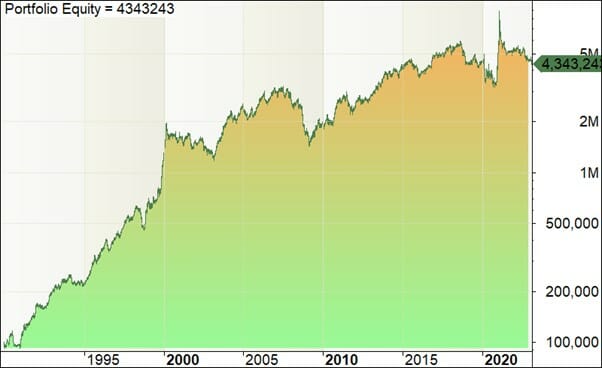
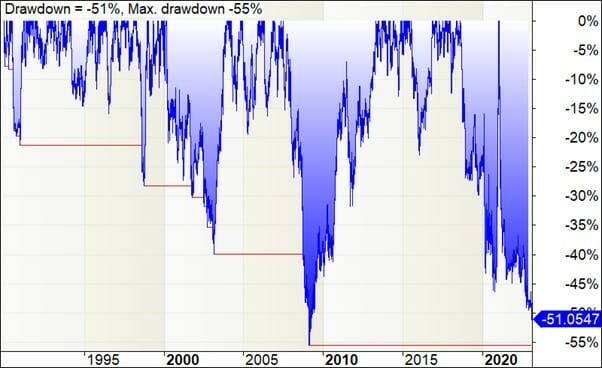
AMEX Trend Trading Performance
The performance of the trend trading strategy applied to stocks listed on the AMEX exchange (now called the NYSE American) has been fairly terrible. The compound annual return was barely positive at 2% and the drawdown was substantial at 43%. Based on this performance and the erratic equity curve it seems a fair conclusion that stocks listed on the AMEX stock exchange do not trend well in comparison to the NYSE and Nasdaq stocks.
Backtest Performance Statistics for AMEX Stock Market Trend Trading System:
- Annual Return % 2%
- Risk Adjusted Return % 6%
- system % drawdown -43%
- CAR/MaxDD 0.05
- Profit/Loss 2%
- Winners 35%
- Average Win / Average Loss 2.18
Note that these backtest results are only on currently listed AMEX stocks because the delisted stock history provided by Norgate does not specify which exchange they were listed on prior to delisting. Performance metrics are still useable because despite some survivorship bias in the results, you will see in the delisted stocks section of this analysis that the trend trading performance for stocks that have now been delisted was actually stronger than for currently listed stocks.
Backtest Equity Curve for NYSE Stock Market Trend Trading System (Log Scale):

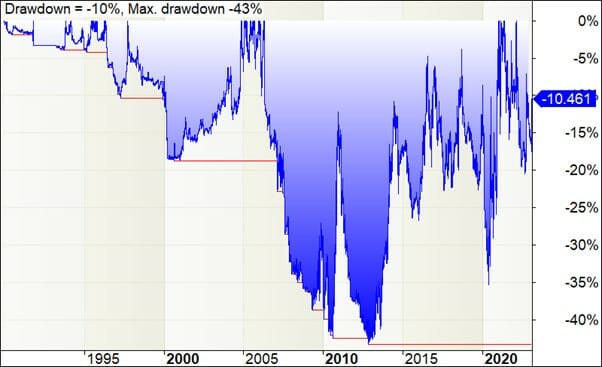
Delisted US Stock Trend Trading Performance
There is often a lot of crowing by certain well know trading educators about how survivorship bias ruins your trading results by making them excessively optimistic. There are two types of survivorship bias:
1. Index constituent survivorship bias: This is where you backtest a system for example on the current 500 stocks in the S&P500 Index and make decisions based on the backtest. This is a HUGE problem because your backtest is cheating because it has advanced knowledge of which stocks will survive and become part of the index in the present day. This type of survivorship bias must be avoided at all costs.
2. Company survivorship bias: This is where you backtest on the whole market (not just stocks in the index), but you only backtest with the currently listed stocks because you don’t have data for all the delisted stocks. Luckily Norgate provided data for all of the delisted stocks in the US, ASX and TSX, but outside that delisted data is not generally available. Now many people refuse to trade outside these markets because they don’t have delisted data, but if you are using a trend trading system this is really not a problem because trend trading systems typically work very well on stocks that have previously been delisted… so this means that by backtesting your system on currently listed data only you are not being overly optimistic (unlike in the case of index constituent survivorship bias). To demonstrate this, I have applied our trend trading system to all delisted stocks in the US, and the performance stats are below. In fact, one could argue that by backtesting this system without the delisted stocks (in the NYSE, Nasdaq & Amex analysis presented above) we were actually being conservative since the delisted data gives better results! Since delisted stock data is not available for markets outside US, ASX and TSX, we have to accept we are only backtesting on currently listed stocks for these markets, however, as we have shown, this does not introduce any material bias or optimism, in fact I have found the opposite in that including delisted stocks generally improves the backtested performance of trend trading systems.
Of course we can’t trade delisted stocks in real time, I just wanted to include this analysis so that I don’t get 50 comments below about how my test results have survivorship bias and are therefore wrong… if that is what you are thinking then I recommend you investigate further if that is the case. Many of my systems perform dramatically better when delisted stocks are included compared to when they are not (this is a good thing).
Backtest Performance Statistics for Delisted US Stocks Trend Trading System:
- Annual Return % 12%
- Risk Adjusted Return % 12%
- system % drawdown -58%
- CAR/MaxDD 0.20
- Profit/Loss 6%
- Winners 42%
- Average Win / Average Loss 2.24
Note that these backtest results are only on currently listed Nasdaq stocks because the delisted stock history provided by Norgate does not specify which exchange they were listed on prior to delisting. Performance metrics are still useable because despite some survivorship bias in the results, you will see in the delisted stocks section of this analysis that the trend trading performance for stocks that have now been delisted was actually stronger than for currently listed stocks.
Backtest Equity Curve for Delisted US Stocks Trend Trading System (Log Scale):


Toronto Stock Exchange (TSX) Trend Trading Performance
The trend trading strategy applied to the Toronto Stock Exchange performs spectacularly well considering the system is so simple. The compound annual return was 16% with a maximum drawdown of 34% and CAR/MDD of 0.46. Considering how simple and unoptimized this trading system is, this shows that there is huge potential for profitable trend trading in Canadian stocks.
This is why in The Trader Success System we provide several great trading systems for the Toronto Stock Exchange. It is one of my favourite markets because of the strong trends that it’s stocks often experience.
Backtest Performance Statistics for Toronto Stock Exchange Trend Trading System:
- Annual Return % 16%
- Risk Adjusted Return % 17%
- system % drawdown -34%
- CAR/MaxDD 0.46
- Profit/Loss 15%
- Winners 48%
- Average Win / Average Loss 3.06
Backtest Equity Curve for Toronto Stock Exchange Trend Trading System (Log Scale):
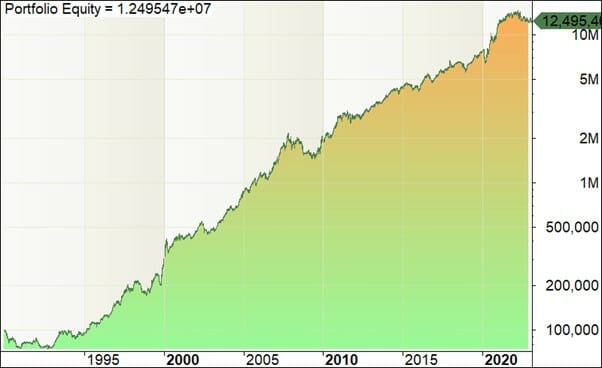

Australian Stock Exchange (ASX) Trend Trading Performance
The trend trading strategy applied to the Australian Stock Exchange performs pretty respectably considering how simple the system is. The compound annual return was 11% with a maximum drawdown of 36% and CAR/MDD of 0.30.
You may notice that the equity curve seems to have two distinct phases, 1990 – 2007 and then 2007 – 2023. Trend trading on the ASX performed extremely well during the early phase, however since 2007 the rate of return from trend trading on the Australian Stock Exchange certainly seems to have dropped. I have seen this on other systems as well – it seems like there was a structural shift in the market around 2007 which changed the effectiveness of these systems.
Despite this shift, trend trading systems are still very profitable on the Australian Stock Exchange and I have a number of highly effective systems that use trend trading which are included in The Trader Success System.
Backtest Performance Statistics for Australian Stock Exchange Trend Trading System:
- Annual Return % 11%
- Risk Adjusted Return % 12%
- system % drawdown -36%
- CAR/MaxDD 0.30
- Profit/Loss 13%
- Winners 42%
- Average Win / Average Loss 3.20
Backtest Equity Curve for Australian Stock Exchange Trend Trading System (Log Scale):

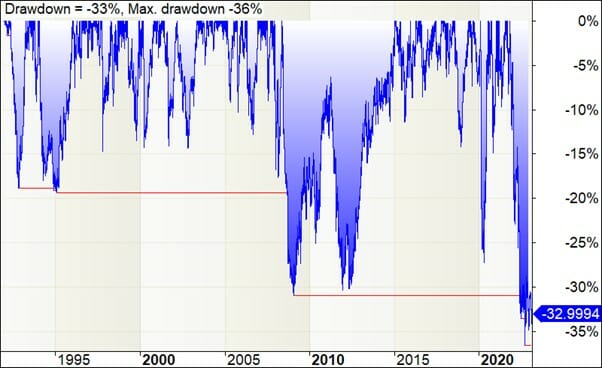
Hong Kong Stock Exchange (HKSE) Trend Trading Performance
If you have watched some of my YouTube videos then you are probably aware that I am a big fan of the Hong Kong Stock Exchange as a source of diversification for my trading. The reason I like the HKEX is that it tends to have a low correlation with the other markets I trade like US, ASX and TSX.
The trend trading strategy applied to the Hong Kong Stock Exchange at face value seems to perform well with a compound annual return of 14%, but the maximum drawdown is extremely high at 69% and closer inspection of the equity curve certainly looks like something has changed since the peak in around 2018.
With my own trading I do not trade with long term trend following in Hong Kong because I have found a swing trading timeframe and strategy to perform much better. Based on this equity curve I am kind of glad this has been my approach because trend trading in Hong Kong could be in trouble.
Regardless of the prospects for trend trading, I do include a highly profitable and stable swing trading system for the Hong Kong market in The Trader Success System which I use to get some excellent performance and diversification in my own portfolio.
Backtest Performance Statistics for Hong Kong Stock Exchange Trend Trading System:
- Annual Return % 14%
- Risk Adjusted Return % 18%
- system % drawdown -69%
- CAR/MaxDD 0.21
- Profit/Loss % 9%
- Winners 39%
- Average Win / Average Loss 2.81
Backtest Equity Curve for Hong Kong Stock Exchange Trend Trading System (Log Scale):


Shanghai Stock Exchange Trend Trading Performance
Broad based trend trading in the Shanghai stock exchange does not perform well at all. The backtest showed a compound annual return of 2% and a maximum system drawdown of 68%. With numbers like this I am not even going to investigate further. Of course other trading strategies may be profitable, but trend trading does not look promising on the Shanghai Stock Exchange at all.
Backtest Performance Statistics for Shanghai Stock Exchange Trend Trading System:
- Annual Return % 2%
- Risk Adjusted Return % 2%
- system % drawdown -68%
- CAR/MaxDD 03
- Profit/Loss % 3%
- Winners 32%
- Average Win / Average Loss 2.70
Backtest Equity Curve for Shanghai Stock Exchange Trend Trading System (Log Scale):
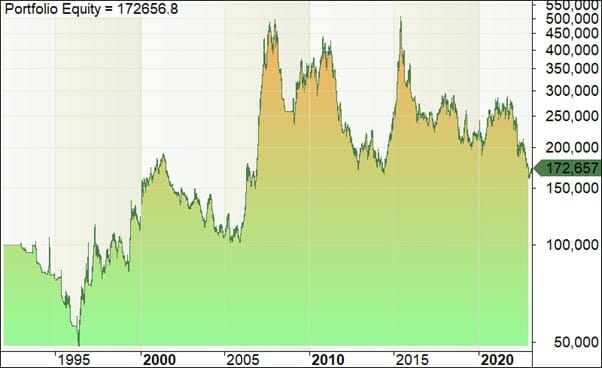
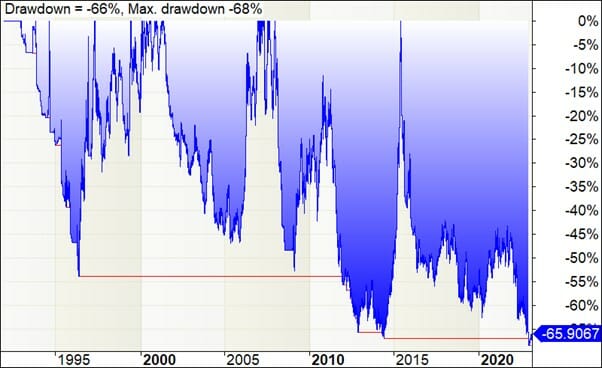
Philippines Stock Exchange Trend Trading Performance
There may be some good potential for long term trend following in the Philippines Stock Exchange. The compound annual return has not been great at just 5%, however there are long periods where the PSE has gone nowhere. For example, from it’s peak in 1997 before the Asian Financial Crisis, the PSE Composite Index did not reach new highs until 2007 – shortly before the Global Financial Crisis. In 2008 the Philippines Stock Exchange suffered a significant drop just like most markets around the world.
However, while the performance long term has been lacklustre, when the Philippines Stock Exchange is trending well, such as in the period from 2023 – 2015 the returns were outstanding. If you were able to filter out the periods where the PSE Composite was sideways volatile or in a down trend with a market regime filter then the Philippines may indeed be a very profitable addition to a global trend trading portfolio.
Backtest Performance Statistics for Philippines Stock Exchange Trend Trading System:
- Annual Return % 5%
- Risk Adjusted Return % 12%
- system % drawdown -29%
- CAR/MaxDD 0.16
- Profit/Loss % 10%
- Winners 42%
- Average Win / Average Loss 2.83
Backtest Equity Curve for Philippines Stock Exchange Trend Trading System (Log Scale):

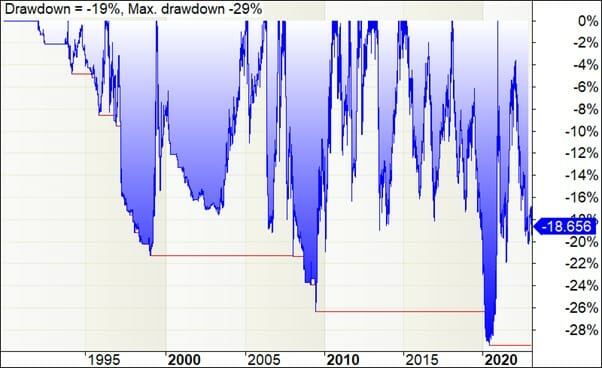
Bursa Malaysia Stock Exchange Trend Trading Performance
Our trend trading system applied to stocks on Bursa Malaysia generated a compound annual return of 7% with a maximum historical drawdown of 55%. This certainly does not fill me with excitement, however when you inspect the equity curve you can see that these gains were made in a fairly stead fashion over the entire backtest period. The bear and sideways markets in Malaysian stocks from 1993 – 2004 certainly reduced the returns our system generated, however with a good market regime filter these could be eliminated and the capital used elsewhere resulting in a very nice looking equity curve (See the second portfolio equity curve).
Backtest Performance Statistics for Bursa Malaysia Stock Exchange Trend Trading System:
- Annual Return % 7%
- Risk Adjusted Return % 10%
- system % drawdown -55%
- CAR/MaxDD 0.12
- Profit/Loss % 8%
- Winners 41%
- Average Win / Average Loss 2.57
Equity Curve – Bursa Malaysia Stock Exchange Trend Trading


The adjusted system to include special market regime filter similar to other systems in The Trader Success System is shown below. This single change in the system rules improved the compound annual return from 7% to 17% and reduced the maximum historical drawdown from 55% to 51%.The drawdown is still a little high for my liking, but there are plenty of ways to reduce it further and the returns are certainly interesting enough now to warrant further investigation.
It is amazing how much difference it makes to just stop taking trades when the broader market is not trending up!
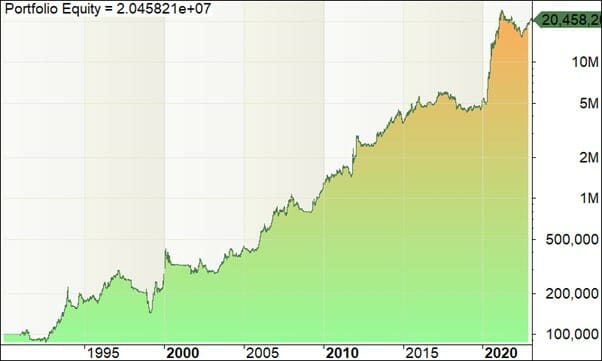
Tokyo Stock Exchange Trend Trading Performance
One of my biggest frustrations as a trader has long been that I don’t have a great system for trading the Tokyo Stock Exchange. This analysis shows why… I am a trend trader at my core, it is the trading style that I naturally gravitate towards, yet look at how poorly our simple trend trading system works on the Tokyo Stock Exchange!
Over the last 33 years trend trading with this system actually lost money! Returning an average of -3% per year with a worst drawdown (so far) of 85%. I think it is safe to say that long term trend following is NOT the way to make money trading the Tokyo Stock Exchange!
Backtest Performance Statistics for Tokyo Stock Exchange Trend Trading System:
- Annual Return % -3%
- Risk Adjusted Return % -3%
- system % drawdown -85%
- CAR/MaxDD -0.03
- Profit/Loss % 0%
- Winners 32%
- Average Win / Average Loss 2.11
Backtest Equity Curve for Tokyo Stock Exchange Trend Trading System (Log Scale):

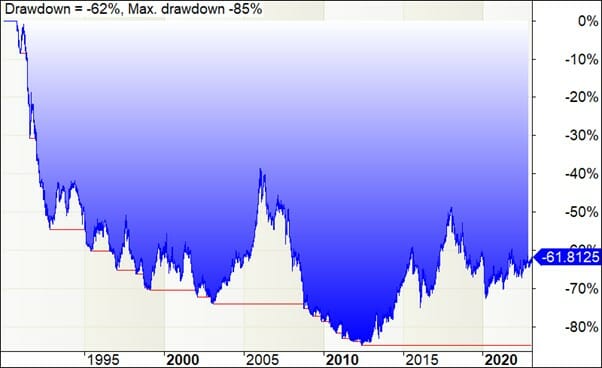
Singapore Stock Exchange Trend Trading Performance
I love Singapore, it is one of my favourite countries, but I don’t love the Singapore Stock Exchange. The Singapore Stock Exchange has basically gone sideways since 2009 and just doesn’t have enough stocks for a diversified long term trend trading system like this one to make good returns.
While the average annual return was 5% in the backtest, this was all earned prior to 2007 and since then the system has been in drawdown. If the Singapore STI index (the main index for the Singapore Stock Exchange) ever breaks out strongly then trend trading may make a comeback, but for now the market is just not that attractive for trend trading.
One possible reason for this is that the dividend yield on the SGX is quite high (3.7% in 2021 according to Asktraders.com, so capital growth may be a lower proportion of total returns that dividends. Note that our backtests do not include dividends other than for US, ASX and TSX.
Backtest Performance Statistics for Singapore Stock Exchange Trend Trading System:
- Annual Return % 5%
- Risk Adjusted Return % 8%
- system % drawdown -39%
- CAR/MaxDD 0.12
- Profit/Loss % 8%
- Winners 38%
- Average Win / Average Loss 2.87
Backtest Equity Curve for Singapore Stock Exchange Trend Trading System (Log Scale):


Swiss Stock Exchange (SIX) Trend Trading Performance
The Swiss Stock Exchange certainly has some real trend trading potential. Our simple system generated a compound annual return of 13% with a maximum drawdown of just 25%. Looking at the equity curve you can see that there were some very large gains in 1999 / 2000 which are making the results look a little more positive than they otherwise would be, but it looks like there is a strong edge that is stable. The Swiss Stock Exchange is one of the few markets where our trend trading system is not in drawdown at the time of writing (early March 2023) which certainly indicates there may be some good diversification potential from trading the Swiss market.
Backtest Performance Statistics for Swiss Stock Exchange (SIX) Trend Trading System:
- Annual Return % 13%
- Risk Adjusted Return % 19%
- system % drawdown -25%
- CAR/MaxDD 0.52
- Profit/Loss % 67%
- Winners 60%
- Average Win / Average Loss 7.68
Backtest Equity Curve for Swiss Stock Exchange (SIX) Trend Trading System (Log Scale):


Bovespa (Brazil Stock Market) Trend Trading Performance
The Brazil Stock Market (called Bovespa) came to my attention just recently because I have a student in The Trader Success System who asked for help adapting my systems to the Bovespa. As a result I am particularly interested to have a much closer look at this market.
The compound annual return from our simple trend trading system applied to Bovespa was just 4%, however my backtest started in 1990 and my Brazilian stock market data only started in 1999. This is why the risk adjusted return is higher at 10% because there was a long period at the start of the backtest with zero exposure.
The compound annual return from the backtest is not great, but what is promising and interesting is the shape of the equity curve. The consistent up slope indicates that there is certainly potential to improve our returns from trend trading in the Brazil Stock Market by custom designing and fine-tuning a system to this market.
Backtest Performance Statistics for Bovespa (Brazil Stock Market) Trend Trading System:
- Annual Return % 4%
- Risk Adjusted Return % 10%
- system % drawdown -37%
- CAR/MaxDD 0.12
- Profit/Loss % 9%
- Winners 42%
- Average Win / Average Loss 2.55
Backtest Equity Curve for Bovespa (Brazil Stock Market) Trend Trading System (Log Scale):


XETRA Trend Trading Performance
The XETRA market is an electronic stock exchange based in Germany that facilitates the vast majority of stock trades in Germany and is also one of the largest sources of ETF trading in Europe. If you want exposure to Euorpean shares then Xetra is one of the main exchanges to consider.
The compound annual return from our simple trend trading system applied to XETRA was just 8.3% with a risk adjusted return of just over 11%.
Looking at the equity curve, there is absolutely potential to develop a much more attractive trend trading system for the XETRA exchange. The equity curve was somewhat volatile in the early years, however more recently has smoothed out and become more stable.
Backtest Performance Statistics for XETRA Trend Trading System:
- Annual Return 8%
- Risk Adjusted Return 11%
- system % drawdown -42%
- CAR/MDD 20
- Profit/Loss 15%
- Winners 46%
- Average Win / Average Loss 3.13
Backtest Equity Curve for XETRA Trend Trading System (Log Scale):

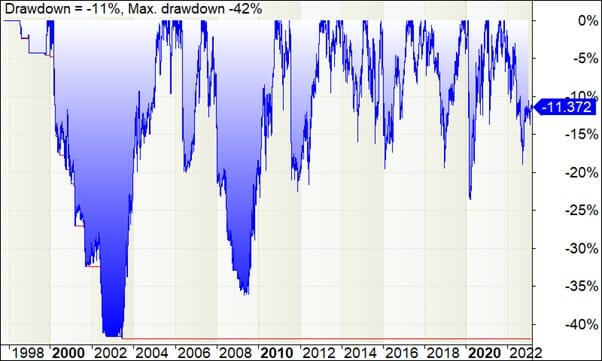
OMX Exchange Trend Trading Performance
The OMX Exchange is owned by Nasdaq and is an exchange that covers stocks in the Nordic and Baltic countries. For the purposes of this analysis I have grouped all of these markets together because some of them have very few stocks. The biggest country represented by number of stocks is Sweden with 1033 of the ~1500 stocks in this group.
The compound annual return from our simple trend trading system applied to the OMX Exchange was 14.1% with a risk adjusted return of 18.6%. This is a huge return for such a simple system and absolutely warrants further investigation.
Looking at the equity curve, there is fantastic potential to develop a very attractive trend trading system for the OMX exchange because the equity curve is smooth and stable with a consistent drawdown profile. I am definitely adding this to my list for further research!
Backtest Performance Statistics for The OMX Exchange Trend Trading System:
- Annual Return 14%
- Risk Adjusted Return 19%
- system % drawdown -26%
- CAR/MDD 54
- Profit/Loss 28%
- Winners 54%
- Average Win / Average Loss 4.01
Backtest Equity Curve for the OMX Exchange Trend Trading System (Log Scale):

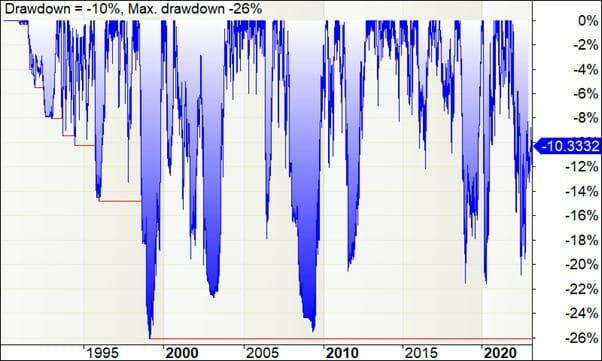
Tel Aviv Stock Exchange Trend Trading Performance
The Tel Aviv stock exchange is the only exchange in Israel. I have not seen a lot of commentary about the exchange so I thought it might be interesting to test our simple trend trading system and see how well it works. The data set I have includes around 900 stocks.
The compound annual return from our simple trend trading system applied to the Tel Aviv Stock Exchange was 10.9% with a risk adjusted return of 15.8%. This is certainly high enough to justify a closer look!
Looking at the equity curve, the edge seems stable with the slope of the logarithmic equity curve being pretty much consistent over time, however there are fairly large drawdowns which would need to be addressed with market regime filters or other system rules before making it tradeable.
Backtest Performance Statistics for The Tel Aviv Stock Exchange Trend Trading System:
- Annual Return 11%
- Risk Adjusted Return 16%
- system % drawdown -43%
- CAR/MDD 25
- Profit/Loss 15%
- Winners 43%
- Average Win / Average Loss 3.25
Backtest Equity Curve for the Tel Aviv Stock Exchange Trend Trading System (Log Scale):

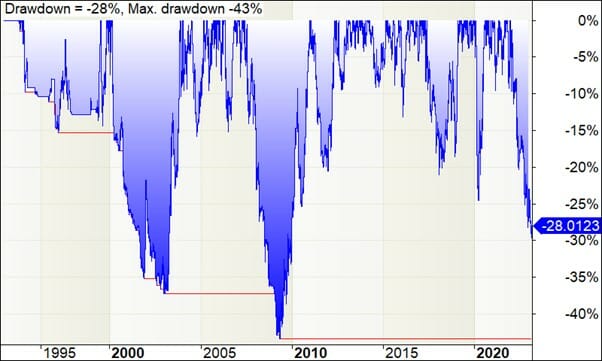
Mexican Stock Exchange Trend Trading Performance
The Mexican Stock Exchange seems to have a large number of dual listings of stocks from other countries, but there are a number of listed local companies too. I thought that this may provide some interesting diversification from US Stocks, plus the Mexican Stock Exchange is tradeable on Interactive Brokers, so I thought it would be a good inclusion in this study.
The compound annual return from our simple trend trading system applied to the Mexican Stock Exchange was 11% with a risk adjusted return of 19%. This is high enough to justify a closer look and has serious potential given how low the drawdowns have been since 2000.
Looking at the equity curve, the edge seems stable with the slope of the logarithmic equity curve is quite consistent over time. One of the appealing traits is that the system only has a very small drawdown at the time of writing while other markets are sitting in much more substantial drawdowns.
Note the sudden jump in the equity curve in about 2001 is likely an outlier that should be removed for further testing as it will likely skew any optimization decisions and also artificially improves the performance statistics as well. Despite this I think the Mexican Stock Exchange might be a good market for further research into trend trading systems.
Backtest Performance Statistics for The Mexican Stock Exchange Trend Trading System:
- Annual Return 11%
- Risk Adjusted Return 19%
- system % drawdown -32%
- CAR/MDD 34
- Profit/Loss 37%
- Winners 50%
- Average Win / Average Loss 5.76
Backtest Equity Curve for the Mexican Stock Exchange Trend Trading System (Log Scale):
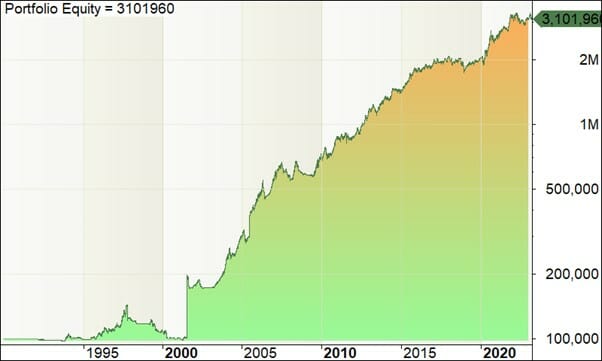

Conclusion on Global Stock Markets Trend Trading
As we have seen, there are many stock markets around the world that have great profit potential for trend trading strategies. In particular it is notable that whole of market trend trading in US stocks is not particularly attractive, however trend trading on the NYSE exchange is much more profitable and promising.
Global markets that may warrant attention for trend trading include:
- Canada
- Australia
- Hong Kong
- Malaysia
- The Swiss market
- Bovespa
- Xetra (Germany)
- OMX (Nordic and Baltic)
- Tel Aviv
- Mexico
More will become apparent as I continue to extend this research. Leave me a comment below if there is a particular market you would like me to include in this study and I will add it to the article.
These global markets present an outstanding diversification opportunity which can greatly enhance many trader’s portfolios. If global diversification is something you would like to build into your portfolio then join The Trader Success System where you will learn:
- how to apply mechanical trading systems like this to reduce the time your trading takes to just 20-30 minutes a day
- eliminate the impact of your emotions on your trading by building rock solid confidence through backtesting
- smooth your returns by implementing a diversified portfolio of trading systems that cover a variety of markets / strategies / timeframes
If you want to become a consistent and confident systematic trader who has the global markets at your fingertips, then join The Trader Success System today. When you do you will get immediate access to many complete trading systems that are substantially better than this simple system we have tested in this article.



